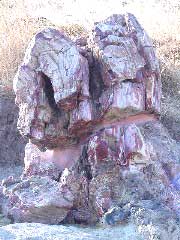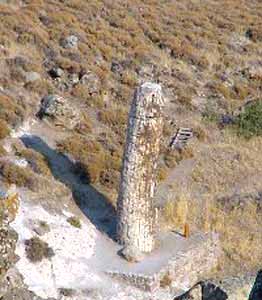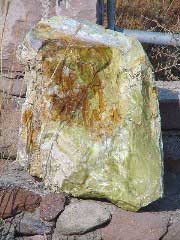Lesvos Petrified Forest - A Flora Pompei
...This park is definitely a unique monument worldwide! A plethora of standing tree trunks, in perfect condition, forms a petrified complete forest ecosystem. Nowhere else in the world are there so many standing petrified tree trunks!...
 In western Lesvos, where the volcanic rocks meet the deep blue of the Aegaen, time, rain, and the waves of the sea bring gradually to light petrified pieces of trees that have lived millions of years prior to man’s appearance on Earth. No description could ever give the proper credit to the grandiosity of the fossils, the beauty and brilliance of their colors, the splendor of the upright tree trunks, and the wild beauty of the landscape. It is a different world, motionless yet having a life of its own. One wonders: why has Hephaestus, god of the chthonic powers and volcanoes, from his headquarters on Lemnos where, according to mythology, he had his workshop, in a moment of wrath, deprived these trees of their life granting them immortality?
The famous petrified forest of Lesvos, contrary to what one could imagine, does not make its appearance at one specific spot; parts of it can be seen throughout Western Lesvos. Nevertheless, the most important concentrations of petrified trunks are in the regions of Sigri, Eressos, and Andissa. Together with the trunks, there are also twigs, roots, fruit, leaves, and seeds preserved in perfect condition in the protection of volcanic rocks.
The very fact that a great number of tree trunks are in an upright position and with their root system intact proves that the trees were petrified in their initial habitat and were not carried to where they exist today. It is, in other words, an indigenous petrified forest that we have here!
The petrified forest informs us of the Palaeoflora makeup, indirectly witnessing the climatic and environmental conditions and their changes; it is, therefore, a unique book in which can be read the geological history of the whole Aegean Basin in the last twenty million years. Scientists stress its uniqueness and its immense scientific value, since it represents a full forest ecosystem petrified on the spot due to intense volcanic activity and preserved in mint condition until today.
Unfortunately, up until well into the 80’s, the petrified forest was totally unprotected and this resulted in widespread destruction, cutting up, removal, and despoliation of the petrified tree trunks. Some twenty years ago, the Greek State, acknowledging the huge environmental, geologic, and palaeontologic importance of the forest, declared it a Protected Monument of Nature and its five parts as Specially Protected Areas. Since then better protection and a more rational management have materialized.
In 1994, the Natural History Museum of the Lesvos Petrified Forest was instituted. Its objectives are study, research, promotion, preservation, and protection of the Forest. The museum is housed in a one-story construction,  built of local grey lava, comprising exhibition halls, library, laboratories, store rooms, a multi function hall, and a guest house. It is, therefore, much more than just a museum, it functions as a Research and Educational Center.
The Museum is normally open to visitors daily from 8:00 to 20:00 during the summer season. Please contact us for detailed information.
Visiting the Petrified Forest.
There are a lot of choices open to people wishing to visit the various areas with concentrations of tree trunks. The specially organized park at “Bali Alonia,” the park at Sigri and the Nissiopi islet are all worth your attention. To trekking and climbing lovers several itineraries are open, all through a landscape that has retained the rare natural beauty created by the volcanic activity of the past, still intact today. Please contact us for more specific details.
In Bali Alonia the visitor enjoys a once-in-a-lifetime experience. This 286,000 square-meter (70.7 acres) park is definitely a unique monument worldwide! A plethora of standing tree trunks, in perfect condition, forms a petrified complete forest ecosystem. Nowhere else in the world are there so many standing petrified tree trunks! The visitor can explore a whole mountainside  through manmade pathways and can see the main excavation area where the largest standing petrified tree trunk in Europe was found. Its height is 7.02 meters (21 feet), and its perimeter 8.58 meters (approximately 26 feet); it is the lowest part of the tree trunk, preserved in magnificent condition. It belongs to Taxodioxylon albertense, ancestor to Sequoia sempervirens, the well-known gigantic Sequoia, growing exclusively on the west coast of the U.S. Nearby, there are a lot of standing trunks belonging to ancestors of pine trees, as well as the longest lying trunk, more than 20-meters (60 feet) long. Furthermore, a lot of parts of petrified trees have been found here, fruits, roots, leaves, etc., which are gradually enriching the Museum exhibits.
Another choice would be to visit Sigri, at the westernmost end of the island. Here, in the vicinity of the Museum, a 20,000 square-meter (approx. 5 acres) open-air exhibition park has been specially arranged; one can admire the impressive petrified conifer trees, ancestors to modern pine and cypress trees, fully intact, with their rooting system and all!
A short caique ride away is the picturesque islet of Megalonissi or Nissiopi. Both conifer and angiosperm fossils are to be seen here, both on dry land and emerging from the sea. |
|



